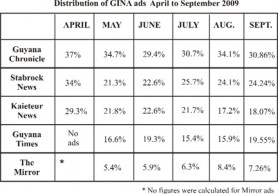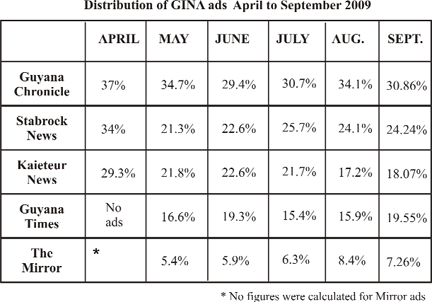Just over a year after it was launched, the Guyana Times is already receiving over 19% of state ads each month when Stabroek News was not given a single one for 17 months because the government alleged that it did not have sufficient readership.
The allocations to the Guyana Times, which has close ties to the Queens Atlantic Investment Inc, whose principal is a friend of President Bharrat Jagdeo, raise again the question about the fairness of the state ads distribution system and the quality of PPP/C governance. It also casts doubt on the explanations that had been given by government spokesmen in January 2007 on the formula for distribution of state advertising.
SN has analysed the distribution of Government Information Agency (GINA) advertisements between April and September this year. In April when no GINA ads were going to GT, the apportioning of ads among the three daily newspapers, the Guyana Chronicle, SN and Kaieteur News was as follows: 37%, 34% and 29.3% respectively. In May this year, when GT started receiving ads, having been in business since only June of 2008 and with dubious market penetration, the distribution for the daily newspapers and the PPP-aligned weekly Mirror was as follows: GC 34.7%, SN 21.3%, KN 21.8%, GT 16.6% and the Mirror 5.4%. In June, the spread was as follows: GC 29.4%, SN 22.6%, KN 22.6%, GT 19.3% and the Mirror 5.9%. In July the figures were as follows: GC 30.7%, SN 25.7%, KN 21.7%, GT 15.4% and the Mirror 6.3%. The August figures were GC 34.1%, SN 24.1%, KN 17.2%, GT 15.9% and the Mirror 8.4%. For September, the figures were GC 30.86%, SN 24.24%, KN 18.07%, GT 19.55% and the Mirror 7.26%.
 In a comment on the situation, Stabroek News Editor-in-Chief (EiC) Anand Persaud said that the distribution pattern comprehensively demolishes the government’s arguments about why Stabroek News was denied state advertising between November 2006 and May 2008. He said that after ads begun to be allocated to GT, Stabroek News had written to GINA querying the basis for the decision. He noted that the reply from GINA that the GINA Advertising Unit had “no obligation to explain its placement of advertisements to the Stabroek News” was redolent of the intransigence and opaqueness of PPP/C government decisions. He also noted that no government official has since provided an explanation of the decision for ads in GT even though several had offered contrived defences of GINA policy when SN went public over the ads cut-off in January, 2007.
In a comment on the situation, Stabroek News Editor-in-Chief (EiC) Anand Persaud said that the distribution pattern comprehensively demolishes the government’s arguments about why Stabroek News was denied state advertising between November 2006 and May 2008. He said that after ads begun to be allocated to GT, Stabroek News had written to GINA querying the basis for the decision. He noted that the reply from GINA that the GINA Advertising Unit had “no obligation to explain its placement of advertisements to the Stabroek News” was redolent of the intransigence and opaqueness of PPP/C government decisions. He also noted that no government official has since provided an explanation of the decision for ads in GT even though several had offered contrived defences of GINA policy when SN went public over the ads cut-off in January, 2007.
Persaud contended that the current situation makes a mockery of the statements that had been made by several government officials and most importantly President Jagdeo. Government spokesman, Dr Prem Misir had said on several occasions that government ads were being placed in the KN and the GC because the government had discerned “huge responses” to its ads in these papers. He did not provide any evidence for this. He had also argued that KN had a higher circulation without providing figures.
Persaud pointed out that in a statement issued on January 15, 2007, GINA said “The basis for the placement of advertisements in the media is linked to the public’s response to such advertisements. Huge responses to our advertisements emanate from the Kaieteur News and Guyana Chronicle. And we are constantly seeking to maximize the impact of its advertisements, in the interest of efficiency… Kaieteur News today is the largest private newspaper in this country and therefore attracts a disproportionately greater number of government’s advertisements. An added advantage with releasing numerous advertisements to Kaieteur News has to do with its wider dissemination not only nationally but also internationally within the Guyanese Diaspora in New York City”.
President Jagdeo had said much the same on January 26, 2007 when he told reporters before leaving on a trip to Russia that the axing of GINA ads to SN was purely a business decision and that the government would advertise in two dailies – the state-owned Guyana Chronicle and the privately-owned KN and some newspapers published at the weekend – a reference to the Mirror newspaper.
In October 2007, the President had also said “Suddenly, because there is this shift, they [SN] are now making it a press freedom issue. It is not a press freedom issue because we have not stopped spending the government’s revenue in advertising in the private sector or private newspapers. We have just made a switch to the larger circulating newspaper [KN] because we get more value for money. We reach more homes with the same amount of money, investing in advertising in that particular newspaper,” the President said. He added that if Stabroek News wants to change this the newspaper needs to get its circulation rate up again.
Persaud said the statements by President Jagdeo, Dr Misir and GINA have now been completely undermined by the current allocations. Not only was government now regularly advertising in three private daily newspapers but it seemed as if SN had all of a sudden now become the newspaper with the highest circulation as evidenced by its allotment of 24% in September while KN’s circulation had apparently fallen below that of GT which had 19.55% as compared to the former’s 18.07%.
While SN’s circulation is solid and there have been increases, Persaud said the more likely explanation for the ad distribution changes is that the government is intent on aiding GT and at the same time it has had heated exchanges with KN over several issues and the relationship with that newspaper has frayed. Persaud said that clearly political decisions have come into play in the ads ratio and this is exactly what SN had fought valiantly against for 17 months. Persaud noted that just months before his passing SN’s Editor-in-Chief, David de Caires had argued forcefully that the apportioning of ads should be done on a professional basis and taken out of the hands of the politicians at the Office of the President.
He had argued that the distribution of state ads should be assigned to a professional advertising agency which would be aware of not only the paid circulation of the various newspapers but also the segments of the market that they reach. For instance, SN has been widely recognized as being the most read journal in the business community. These factors should then determine the sharing of ads. De Caires had proposed that an Audit Bureau of Circulation team from somewhere in the Caribbean be deputed to conduct an analysis of circulation patterns. Persaud noted that these very reasonable proposals by de Caires were completely ignored by President Jagdeo.
Persaud said the gymnastics over the apportioning of ads should be of great interest to donors and others who are concerned with good governance and accountability for taxpayers’ dollars. The new developments he said also constituted a breach of the hemispheric press freedom Declaration of Chapultepec which says at principle 7 “Tariff and exchange policies, licences for the importation of paper or news-gathering equipment, the assigning of radio and television frequencies and the granting or withdrawal of government advertising may not be used to reward or punish the media or individual journalists.” Persaud said the new allocations are intended to reward GT – because how else could their allotment of 19.55% for September be rationalized against 0% to SN for 17 months even though the newspaper had been in existence for 21 years and was widely recognized as a credible, authoritative and independent voice.
Persaud said that when all the events from the cessation of SN’s state ads in November 2006 to the present distribution pattern were taken into account, an observer could reasonably come to the conclusion that the government was aware of the plans to establish GT and it was decided that SN would be targeted as it was an independent voice that had kept the pressure on the administration to be accountable.
The SN EiC said that the latest developments will be drawn to the attention of international press organizations and the press freedom monitor, Freedom House in the usual end-of-year reports.
He said the new developments were also a seminal lesson to the media about solidarity on press freedom issues. Persaud recalled that when Stabroek News’ ads were cut off, the Kaieteur News sided with the government and happily harvested the increased amount of advertising that was then available to it. Further, in October 2007 when SN mounted an historic protest against the government over the ads issue, the KN hierarchy instructed its staff not to offer solidarity to this newspaper. Persaud said that KN unthinkingly allied itself to the government without realizing that it too could eventually become a target as it was now contending following a suggestion by President Jagdeo at a recent private sector dinner that the business community was contributing to certain types of reporting by continuing to advertise with the newspapers in question. Persaud said the President’s remark was one that referred not only to KN but all other media houses including SN. He said SN would offer solidarity to KN once it was clear that the government was targeting it.
Persaud also disputed a recent statement in a letter by R. Ravie Ramcharitar, Director of the Guyana Times Inc in the September 30, 2009 edition of SN that said “The Guyana Times, in fact, attracts a substantially greater amount of ‘prestige’ advertisements than its competition because it is a quality newspaper, politically independent and enjoys a superior circulation and readership among the business and professional community.”
Persaud said there was a lot that could be said about the GT claim of being politically independent but he was more concerned about the claim that GT enjoyed a superior circulation among the business and professional community. Persaud said this was an incredible statement for a year-old newspaper as SN – in the business for 23 years – has always been considered the newspaper most read by the business community, has had a longstanding business edition in addition to the well-read Sunday columns of chartered accountant Christopher Ram, economist Dr Clive Thomas and trade expert David Jessop. More recently Dr Tarron Khemraj has also been doing high quality business columns in the daily newspaper. In addition, its annual budget coverage and detailed analysis by Ram and McRae had no equal.
Commentators have also raised eyebrows at the ad allocations to the Guyana Chronicle. Over the period surveyed it averaged the highest figure of 32.7% though it is known to have a very low circulation. SN averaged 25.32%, KN 21.7% and GT 17.35%. GT moved from 16.6% in May to 19.55 in September while KN slid from 29.3% in April to 18.07% in September.







